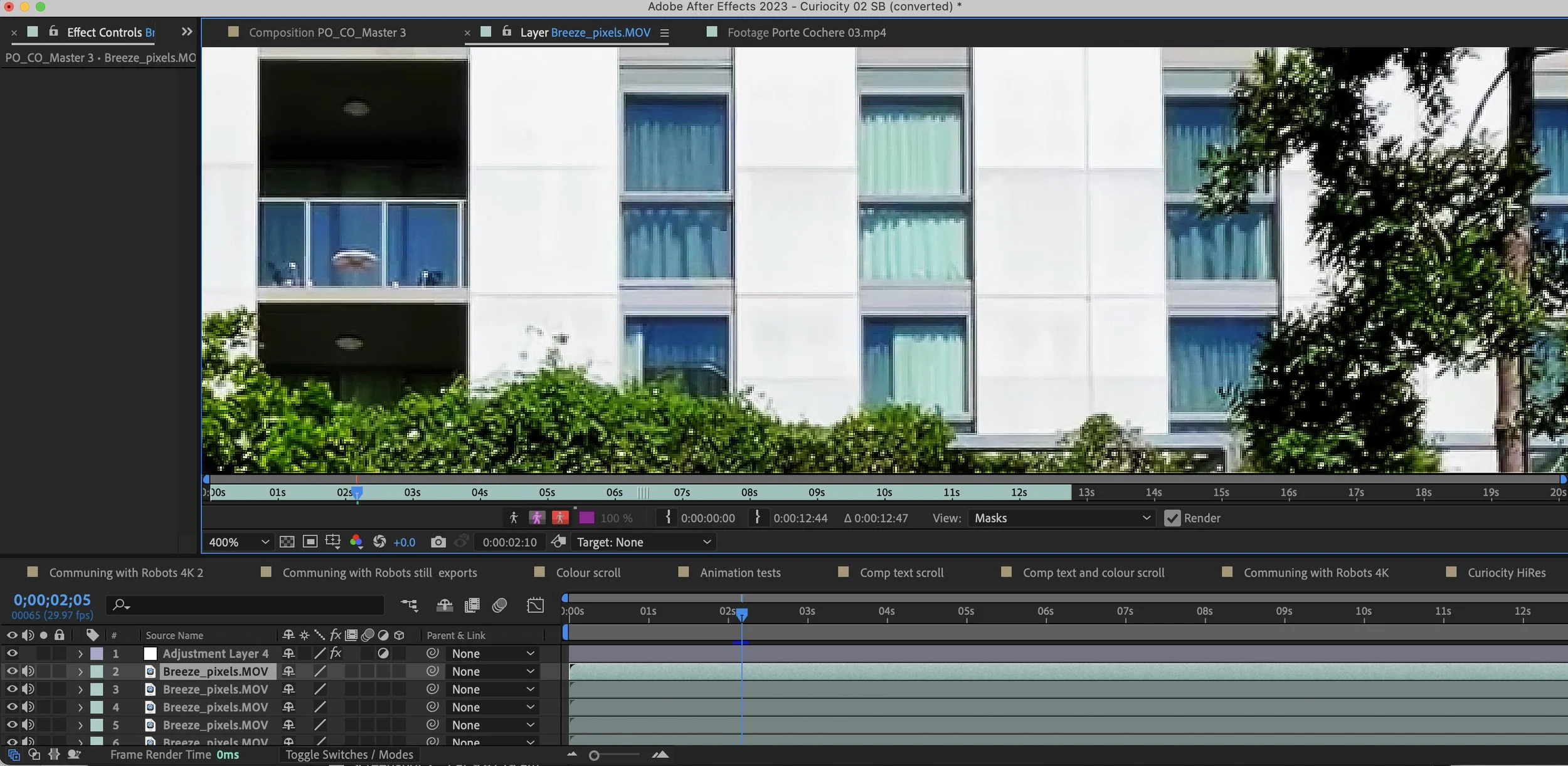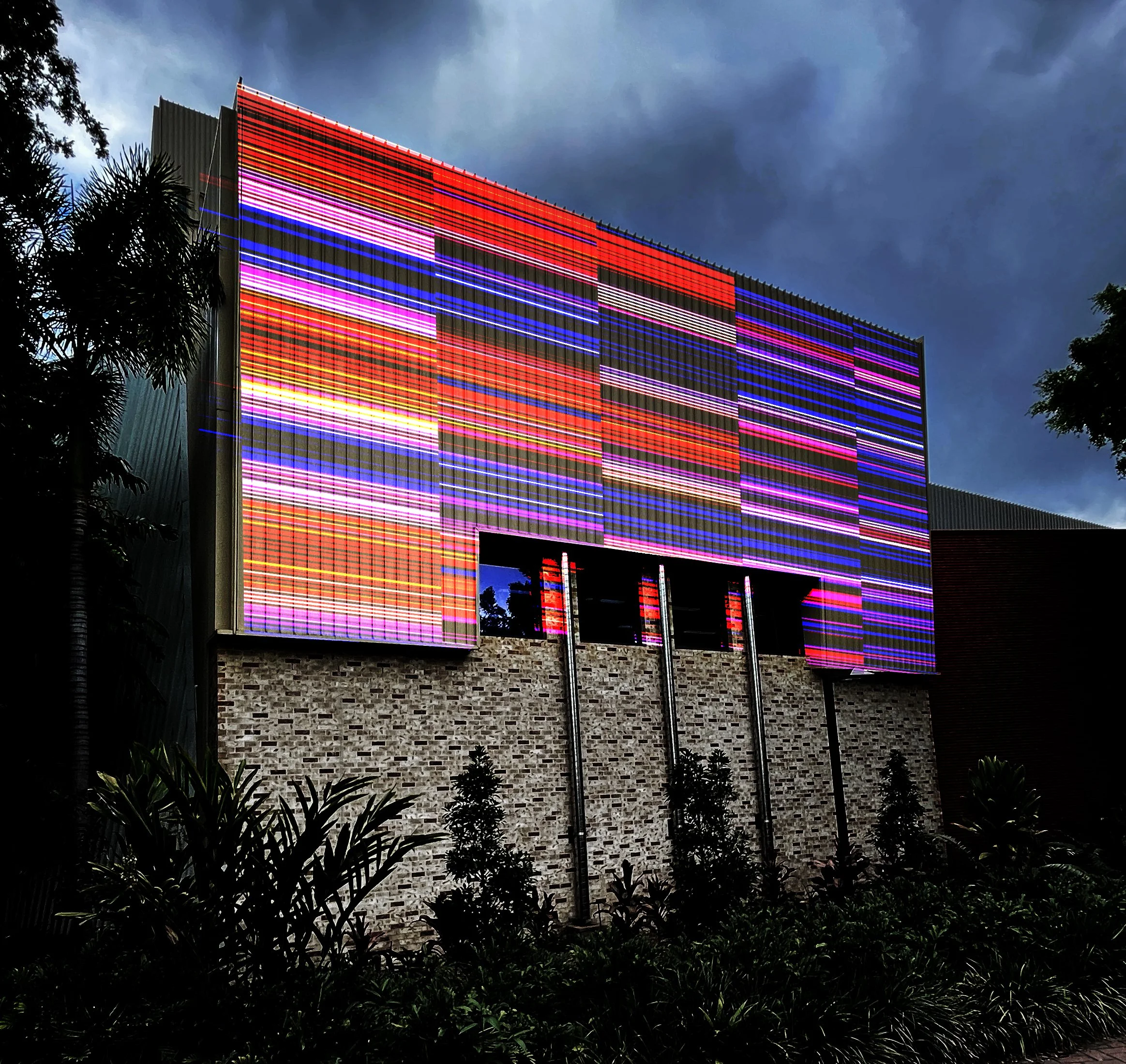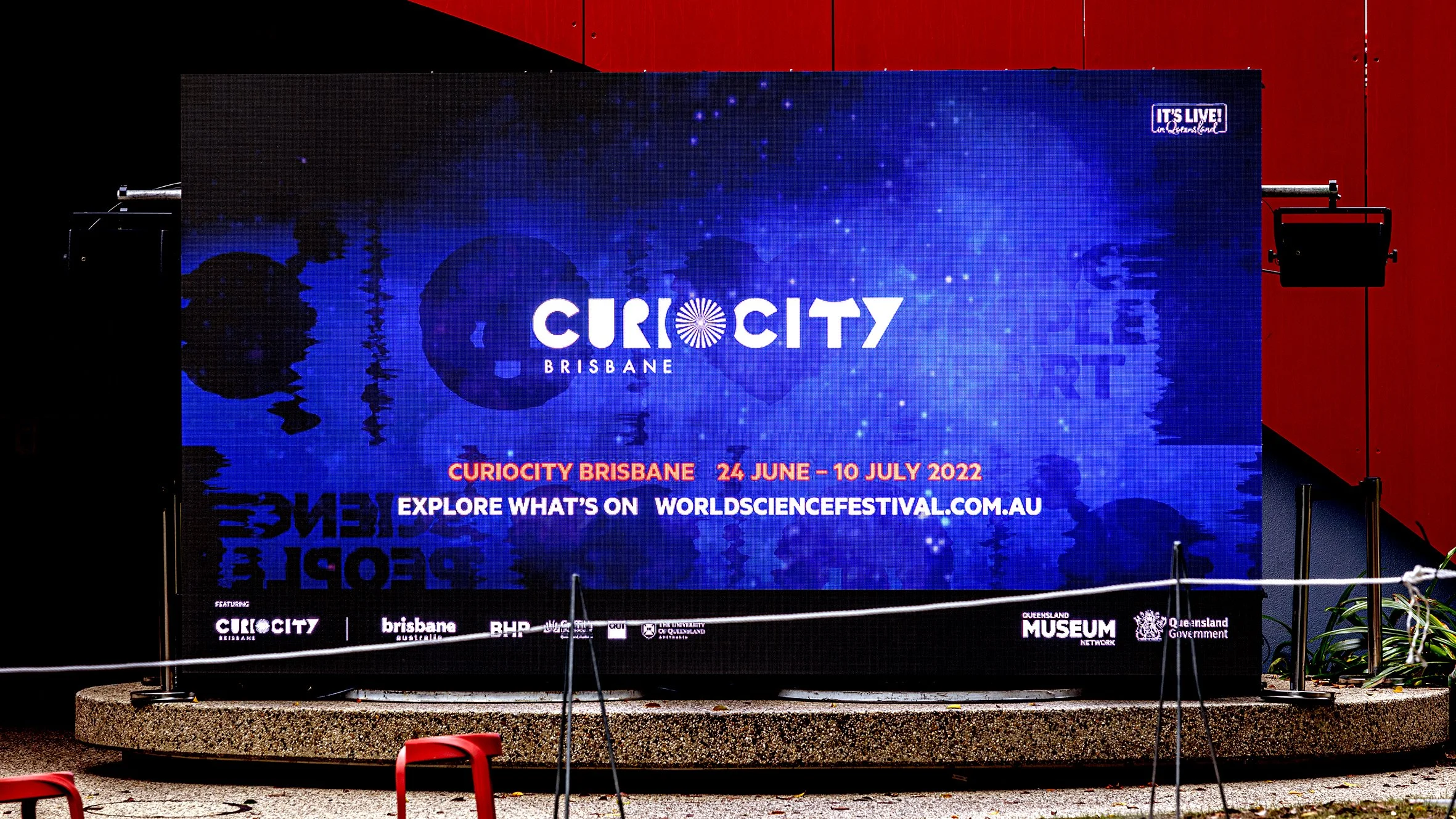peter thiedeke
image maker
Communing with robots: AI nonsense
Background
Communing with robots is a video installation in the South Bank Parklands as a contribution to the outdoor public art exhibition Curiocity at The World Science Festival Brisbane 2022, which had a visitation of approximately 200,000 people from the 24th of June to the 10th of July 2022
Communing with robots aimed to provide cathartic relief to the pervasive use of technologies and the rhetoric surrounding them through a slightly subversive creative work that momentarily re-shaped a tiny part of the public sphere.
Paradoxically, however, the work unintentionally evolved into a banal device that resembles the ubiquitous screens used for advertising and urban informatics that monitor and influence public mobility for modifying citizens’ behaviours.
An expositional film about the making of Communing with robots and its installation as public art
00:00-02:20 Prologue: Setting the scene
02:20-04:00 Act One:Sensing the City–Formulating the work’s background pseudo-surveillance imagery
04:00-07:40 Act Two: Formulating nonsense AI prose and poetry–OpenAI’s GPT-2 and the InferKit web interface fro AI-based text generation
07:40-13:50 Act Three: The composited pseudo-surveillance imagery and nonsense AI prose and poetry (as installed in theSouth Bank Parklands)
13:50-15:10 Act Four: The installation at the World Science Festival Brisbane, Australia, June 24-july10, 2022
15:10-17:15 Finale: An urban problematic–The unintentional pseudo-advertising device
*This documentary film was made with the assistance of robots. The voices in this film are all synthetic speech generated AI created using text to speech (TTS) tools. The sound was not used in the South Bank installation.
Concept
Communing with robots is a post-digital artwork situated within the contexts of Smart City urban informatics, media architecture and digital placemaking in the coming age of the internet of things (IoT) and artificial intelligence (AI). Communing with robots questions how an individual’s sense of trust and privacy might be affected in cities where social spaces are increasingly subjected to and mediated by information communications technologies and the dominant tendency of markets to penetrate and dissimulate reality with visual spectacles for mass consumption. This playful ‘civic hack aimed to connect people’s imaginations to the aesthetics of surveillance and the invisible predictive data analytics that occupy public space.
The OpenAI GPT-2 algorithm. GPT-2–a relatively unknown precursor to the ubiquitous ChatGPT-3.5 released the year after this project was completed–was used to create absurd AI prose and poetry by repeatedly asking it Can I trust you? and in each instance, GPT-2 responded differently. This activity was a relatively obscure and emergent practice in 2022. However, by January 2023, within a year of the Communing with robots’ conception, the rapid worldwide communion with ChatGPT-3.5 had reached 100 million monthly active users just two months after its launch– 'the fastest-growing consumer application in history’ (Hu 2023). This phenomenon indicates the speed at which industrialised AI can reduce global populations' everyday social and mental experiences into a capital commodity.
The AI nonsense prose and poetry aimed to draw attention away from the technologically determined uses of artificial intelligence technologies, which serve political, social, and economic interests, particularly in public space where the ‘smart everything paradigm’ presents ‘business opportunities’ for data collection in the urban environment. The work intended to subvert the rhetoric surrounding the technical operations of AI, which are intentionally concealed and often centred on cultures of fear and the dangers of malicious use of AI, which includes automated cyberattacks, data poisoning, hacking, novel attacks that use impersonation, deep fakes, and speech synthesis; attacks that use physical systems such as drones and autonomous vehicles; and targeted political persuasion and propaganda that undermine democracy and public debates by modifying human behaviours, moods, and beliefs.
These texts were remixed with abstracted pseudo-surveillance video imagery, captured with an iPhone in the street to mimic the networked surveillance camera systems used in public places that monitor the urban environment. Together, the imagery and text were given form as kinetic animated typographic and graphic elements that imitate the tropes of film credits the scrolling social media feeds
The final video file used in the installation in the South Bank Parklands
Above: This silent video file was exhibited at Curiocity Brisbane in association with The Queensland Museum Network atThe World Science Festival from the 24th of June to 10 July 2022.
The pseudo-surveillance imagery
Video imagery of the urban environment, conceived as pseudo-surveillance imagery, was created to form the background of Communing with robot’s kinetic text. Like the experiments with GPT-2, these images were made heuristically as a responsive and playful mode of artistic inquiry into how algorithmically enhanced surveillance cameras might see, understand, and re-interpret the world. I captured this imagery with an Apple iPhone as I walked down the street, mimicking the PTZ (pan-tilt-zoom) surveillance cameras I observed attempting to track and monitor my activities.
Above: This PTZ (pan-tilt-zoom) surveillance camera at Grey St., South Bank, appeared to respond to my presence and observe and track my motion as I used my iPhone to record it.
The iPhone imagery was ingested into Adobe After Effects, which was manipulated to imitate surveillance camera systems’ translation modes and reimagine how networked surveillance camera algorithms might misinterpret the world when the physical world is blurred in digital environments.
Above: RAW iPhone footage of the architectural facades on Grey St in the Adobe After Effects interface before abstraction, reconfiguration, and fusion.
The video footage was progressively abstracted in After Effects into irrational grid patterns and compositions that break the buildings’ harmonious symmetries to create visual discord about how buildings and street scens could look.
Above: This segment of an upside-down, fragmented raw video clip of Grey St was manipulated in Adobe After Effects by adjusting the source images' instances and orientations.
Above:The image frame was spatially divided into vertical and horizontal blocks, which sporadically changed the grids over time by locating temporal keyframes on the video timeline. The image repetitions were reversed, inverted and mirrored to form irrational abstracted interprertations of the rational city.
The imagery was further reduced to the primary and secondary colours associated with the digital camera’s RGB (red, green, and blue) image sensors, which translate reflected light into digital 0s and 1s that form grid patterns of pixels until an image is formed, or in this case deformed.
Above: This grid section used Adobe After Effects to calculate, compose, and control the image as an abstraction of the Golden Section to destabilise the buildings' harmonic proportions by dividing them into five horizontal sections and 390 vertical lines.
The grids were further segmented and animated into changing sub-sections, adding fluctuation to the aesthetic to imply complexity of the street scene. These themes of grids, proportions, and modernist fragmentation follow traditions of Pythagorean and Platonic conceptions of mathematical order. They conform with the basic principles of the dominant aesthetics of modernist architectural geometries exemplified by Ludwig Mies van der Rohe, whose repetition of geometric form and modernist use of proportion and arrangement of buildings according to grids is prolific in contemporary urban architecture.
























Above: Still images extracted from the generated video with varying horizontal sections and vertical lines.
The proposed installation
The initial proposal for Communing with robots involved the projection of the work onto the exterior of the Queensland Conservatorium of Music. The mock-up image from that proposal shows a video frame superimposed onto an image of the building’s northern facade to illustrate how the building’s architecture could be altered by transposing Communing with robots’ grids onto its surface. The intention was to de-realise the building’s utilitarian facade with discordant digital layers and incoherent poetic nonsense.
Above: This mock-up image was made in Adobe Photoshop to communicate the proposed installation.
The final installation in the South Bank Parklands
The proposal for projected imagery, however, was not considered viable by the festival organisers because daytime viewing was a requirement, so the projection of the work into public space remained untested. Instead, the final form of Communing with robots at Curiocity was a 06:00:00 minute looping image on a standard LED video wall comprising of multiple modular panels.
Above: This image shows the 4.5m wide x 2.5m high multi-channel LED video installation that The Queensland Museum Network commissioned for the public art exhibition Curiocity at The World Science Festival, Brisbane, 2022.
Above: The final frames of the AI gibberish. The installation was exhibited at the South Bank Precinct from the 24th of June to the 10th of July 2022, with seating and a grassy area for citizens to relax.
The latent urban image
It was not until after documenting the finished exhibition installation of Communing with robots at the South Bank Parklands that the subliminal influences on the work became apparent and significant. The many latent memories and associations of my existence within a city mediated by information architectures, my daily routine of interacting with them, their aesthetics, and the agency they bring to my mobility as I travel to and from the city gave the creative work meaning in ways I had not consciously recognised during its making.
On reflection, the aesthetics of the standardised technologies used in Communing with robots’ presentation, which resemble the ubiquitous urban screens used as advertising devices and public wayfinding, were already embedded in the work’s conception before knowledge of its presentation format.
Above: The building directly opposite Platform 1 at South Bank Station supports two surveillance cameras, which, in my imagination, translated as a panoptic schema for behaviour modification.
Above: An LCD screen at South Bank Station presents the train timetables I look at daily on my way to and from work. My embodied experience of their ontological structures subliminally transposed into Communing with robots’ aesthetics.
A paradoxical pseudo-advertising device
Communing with robots potential to mimic and undermine the tropes of urban screens used for advertising and informatics in the Smart City is ironic. While the artwork attempted to subvert mechanisms of mass consumption, it paradoxically became one. The final presentation format of the work exhibited at the South Bank Parklands was subject to the approval processes of the exhibition organisers and city officials. Ultimately, the work was reduced to a function of passive observation and advertising rhetoric, evidenced by the branding of public art by governments and corporations inserted into the installation’s end frames, in this case, incorporated as a feature of the artwork.
Above: The end frame of Communing with robots transformed the subversive post-digital artwork's AI nonsense prose and pseudo-surveillance imagery into a publicly branded pseudo-advertising device.









